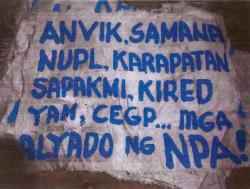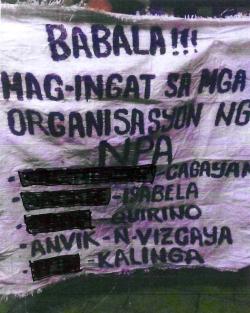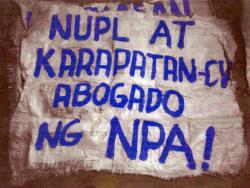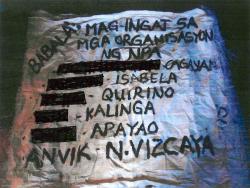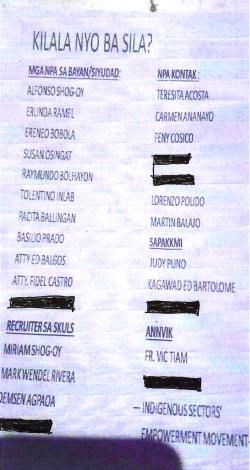(Ottawa/Manila) In October, 27 individuals and a number of organizations in the Philippines found themselves targeted in a way that is a common precursor to extra-judicial killings. The one thing these individuals and organizations have in common is their open criticism of Canadian mining company OceanaGold’s copper-gold mine in the Province of Nueva Vizcaya.
In mid-October, large signs started to appear along major roads and thoroughfares. The crude signs accused various organizations of being associated with the country’s New People’s Army (NPA), an outlawed long-running communist guerilla movement. Following the signs, a pamphlet was distributed with the names of 27 individuals and two organizations. All were accused of being in one way or another associated with the NPA – known in the Philippines as “red-tagging.” Neither the signs nor the pamphlet identified who had produced them.
Five of the individuals targeted live in the village of Didipio, where the OceanaGold mine operates. One is an elected provincial board member. One is lawyer, advocating for critics of the mine, and one is a priest who supports affected villagers. Others include scientists who have lent their expertise to the affected villagers. One of the organizations named, Sapakkmmi, is in the village of Didipio. Other organizations operate provincially and nationally on behalf of villagers from Didipio directly impacted by the mine.
“Getting yourself red-tagged and vilified in the Philippines is often a prelude to murder most foul,” says Clemente Bautista of the Philippine organization Kalikasan People’s Network for the Environment, one of the organizations named on the posters. “The recent massacre of nine sugar plantation workers—and subsequently even their own legal counsel—in the town of Sagay, Negros Occidental Province last October was preceded by months of vilification drives by the military.”
“The only thing these red-tagged people and organizations have in common is that they are known to be critical of the OceanaGold mine and supportive of the locally affected Ifugao Indigenous people,” says Jaybee Garganera of Alyansa Tigil Mina (Alliance Against Mining - ATM). “The mine has had a major negative impact on their food security and water resources, among others.”
“I am the only one named on the pamphlet who does not live in Nueva Vizcaya,” says Manila-based scientist Feny Cosico of AGHAM (Advocates of Science and Technology for the People), “and my organization is also named on the posters. I think it is because we have been helping the people of Didipio to understand the social and environmental impacts of the large-scale mining operation of OceanaGold with the Environmental Investigation Mission that we conducted in 2014.”
“I am the duly elected village head of Didipio where the mine is located.” says Barangay Captain Erenio Bobola. “I think I was named on the pamphlet because I am representing so many people in Didipio that do not want the mine to continue, or to expand, because of all the negative impacts we have been experiencing and the mine’s broken promises.” On October 2, Bobola handed over a petition to Minister Cimatu of the Department of Environment and Natural Resources (DENR) asking for the suspension of the project and asking that the mine comply with its commitments to the people of Didipio in an MOU signed in 2013. Bobola and the village council of Didipio prepared a resolution on October 19, stating that the villagers of Didipio who were ‘red-tagged” are “law abiding citizens” with “no record or involvement in any NPA activities.”
The OceanaGold mine’s 25 year lease comes up for renewal in 2019. Local opposition to the mine is one factor that will be taken into consideration in the mine lease renewal process.
“I am deeply concerned that these Indigenous people, and those who support them, now have targets on their backs for no other reason than that they are standing up against a Canadian mining project that has a history of human rights abuses and unacceptable environmental impacts,” says Catherine Coumans, of MiningWatch Canada. “For that reason the Canadian embassy must do everything in its power to keep these people safe.”
On November 15, Coumans accompanied four villagers from Didipio, three of whose names appeared on the red-tagging pamphlet, as well as Ms. Cosico and representatives of Kalikasan and ATM to the Canadian Embassy in Manila. There information was shared and a discussion was had about how Canada’s “Voices at Risk” policy should be mobilized by embassy staff to help protect these rights defenders.
For more information see:
- Background brief on information shared with the Canadian Embassy in Manila
- Photographs of “red-tagging” posters and pamphlet
- Resolution prepared by the village council in support of the local villagers and their organizations that were “red-tagged.”
Contact:
- Catherine Coumans, MiningWatch Canada, [email protected]
- Jaybee Garganera, Alyansa Tigil Mina, [email protected]
- Clemente Bautista, Kalikasan People’s Network for the Environment, [email protected]
- Feny Cosico, AGHAM (Advocates of Science and Technology for the People), [email protected]
